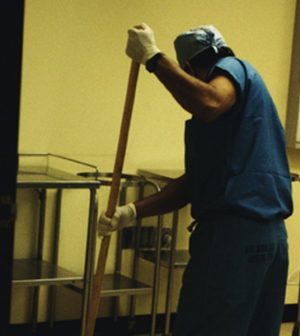- Navigating Your Midlife Crisis: Embracing New Possibilities
- City Raccoons Showing Signs of Domestication
- Mapping the Exposome: Science Broadens Focus to Environmental Disease Triggers
- One Week Less on Social Media Linked to Better Mental Health
- Your Brain Changes in Stages as You Age, Study Finds
- Some Suicide Victims Show No Typical Warning Signs, Study Finds
- ByHeart Formula Faces Lawsuits After Babies Sickened With Botulism
- Switch to Vegan Diet Could Cut Your Greenhouse Gas Emissions in Half
- Regular Bedtime Does Wonders for Blood Pressure
- Dining Alone Could Mean Worse Nutrition for Seniors
COVID Infection Unlikely From Hospital Surfaces: Study

Remember when everyone was disinfecting their groceries at the start of the pandemic, fearful that the new coronavirus could be spread simply by touching a surface on which the virus had landed?
New research confirms that much of that cleaning was unnecessary because people are unlikely to get COVID-19 from contaminated surfaces.
“Early on in the pandemic, there were studies that found that SARS-CoV-2 could be detected on surfaces for many days,” said senior study author Dr. Deverick Anderson, a professor of medicine at Duke University in Durham, N.C. “But this doesn’t mean the virus is viable. We found there is almost no live, infectious virus on the surfaces we tested.”
For the study, Anderson’s team collected samples from several surfaces in the rooms of 20 COVID patients at Duke University Hospital over several days of hospitalization, including days 1, 3, 6, 10 and 14.
Those surfaces included bed rails, sinks, medical prep areas, room computers and exit door handles, as well as nursing station computers outside patients’ rooms.
Of 347 samples, PCR testing found 19 that were positive for the virus. They included nine samples from bed rails, four from sinks, four from room computers, one from a medical prep area and one from an exit door handle.
Of the 19 positive samples, 16 were collected on patients’ first or third day in the hospital, according to findings published recently in the journal Clinical Infectious Diseases.
The 19 samples were screened for infectious virus, and only one had the potential to be infectious, researchers reported. It was collected on the third day of hospitalization from the bed rails of symptomatic patient with diarrhea and a fever.
“While hospital rooms are routinely cleaned, we know that there is no such thing as a sterile environment,” Anderson said. “The question is whether small amounts of viral particles detected on surfaces are capable of causing infections. Our study shows that this is not a high-risk mode of transmission.”
The findings add to a large body of evidence that SARS-CoV-2 primarily spreads through respiratory droplets in the air, according to Anderson.
People should focus on proven infection prevention methods such as masking and socially distancing to limit their exposure to airborne particles, he advised.
More information
For more on COVID-19 protections, visit the U.S. Centers for Disease Control and Prevention.
SOURCE: Duke University, news release, Jan. 18, 2022
Source: HealthDay
Copyright © 2025 HealthDay. All rights reserved.










